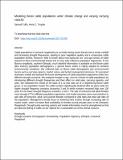| dc.description.abstract | Cattle populations in semiarid rangelands are currently facing severe threats due to erratic rainfall and increasing drought frequencies, leading to poor vegetation quality and a consecutive cattle population decline. However, little is known about how particular sex- and age-cohorts of cattle respond to these environmental threats and on how sales influence population trajectories. In the Borana rangelands, southern Ethiopia, much detailed information is available on the Boran cattle (Bos indicus) population demographics, a special breed, which is highly adapted to semiarid environmental conditions. We collected data on Boran cattle demographic and environmental factors such as carrying capacity, market values, and herderś management decisions. We generated stochastic models and assessed the future development of cattle population trajectories under four different drought scenarios. We analyzed changes in age- and sex-cohorts of cattle populations by introducing different drought frequencies and their effect on vital rates, carrying capacity, and sales. We calibrated the model on the basis of a 12-year data set of a neighboring Boran cattle group. In our population model, the cattle numbers significantly declined after 18 years under the higher drought frequency scenarios (scenarios 3 and 4) while numbers remained high over 100 years for the lower drought frequency scenarios 1 and 2. The sale of senescent and adult females most strongly (77%) affected population trajectories, and model outcomes were most sensitive to sale rates of senescent, adult, and juvenile females compared to vital rates and male sale rates of the population. Management should focus on lowering herd crashes through increasing sale of mature males, which increases feed availability to females during drought years in the Ethiopian Rangelands. Drought early-warning systems and market information must be strengthened so that pre-planned selling of cattle can be realized for a sustainable use of the animal resource. | en_US |

